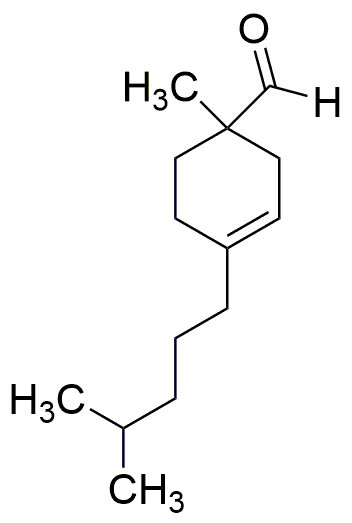Vernaldehyde is widely utilized in research focused on:
- Fragrance Industry: Vernaldehyde is a key ingredient in the formulation of perfumes and scented products, providing a fresh, woody aroma that enhances the overall fragrance profile.
- Flavoring Agents: It is used in the food industry as a flavoring agent, contributing to the taste of various food products, particularly in baked goods and confections.
- Pharmaceuticals: Researchers explore its potential in drug development, particularly in creating compounds that may have therapeutic effects due to its unique chemical structure.
- Cosmetics: The compound is incorporated into cosmetic products for its pleasant scent and potential skin benefits, making it appealing for personal care formulations.
- Research Applications: In academic and industrial research, Vernaldehyde serves as a valuable building block in organic synthesis, allowing chemists to create more complex molecules efficiently.
General Information
Properties
Safety and Regulations
Applications
Vernaldehyde is widely utilized in research focused on:
- Fragrance Industry: Vernaldehyde is a key ingredient in the formulation of perfumes and scented products, providing a fresh, woody aroma that enhances the overall fragrance profile.
- Flavoring Agents: It is used in the food industry as a flavoring agent, contributing to the taste of various food products, particularly in baked goods and confections.
- Pharmaceuticals: Researchers explore its potential in drug development, particularly in creating compounds that may have therapeutic effects due to its unique chemical structure.
- Cosmetics: The compound is incorporated into cosmetic products for its pleasant scent and potential skin benefits, making it appealing for personal care formulations.
- Research Applications: In academic and industrial research, Vernaldehyde serves as a valuable building block in organic synthesis, allowing chemists to create more complex molecules efficiently.
Documents
Safety Data Sheets (SDS)
The SDS provides comprehensive safety information on handling, storage, and disposal of the product.
Product Specification (PS)
The PS provides a comprehensive breakdown of the product’s properties, including chemical composition, physical state, purity, and storage requirements. It also details acceptable quality ranges and the product's intended applications.
Certificates of Analysis (COA)
Search for Certificates of Analysis (COA) by entering the products Lot Number. Lot and Batch Numbers can be found on a product’s label following the words ‘Lot’ or ‘Batch’.
*Catalog Number
*Lot Number
Certificates Of Origin (COO)
This COO confirms the country where the product was manufactured, and also details the materials and components used in it and whether it is derived from natural, synthetic, or other specific sources. This certificate may be required for customs, trade, and regulatory compliance.
*Catalog Number
*Lot Number
Safety Data Sheets (SDS)
The SDS provides comprehensive safety information on handling, storage, and disposal of the product.
DownloadProduct Specification (PS)
The PS provides a comprehensive breakdown of the product’s properties, including chemical composition, physical state, purity, and storage requirements. It also details acceptable quality ranges and the product's intended applications.
DownloadCertificates of Analysis (COA)
Search for Certificates of Analysis (COA) by entering the products Lot Number. Lot and Batch Numbers can be found on a product’s label following the words ‘Lot’ or ‘Batch’.
*Catalog Number
*Lot Number
Certificates Of Origin (COO)
This COO confirms the country where the product was manufactured, and also details the materials and components used in it and whether it is derived from natural, synthetic, or other specific sources. This certificate may be required for customs, trade, and regulatory compliance.


